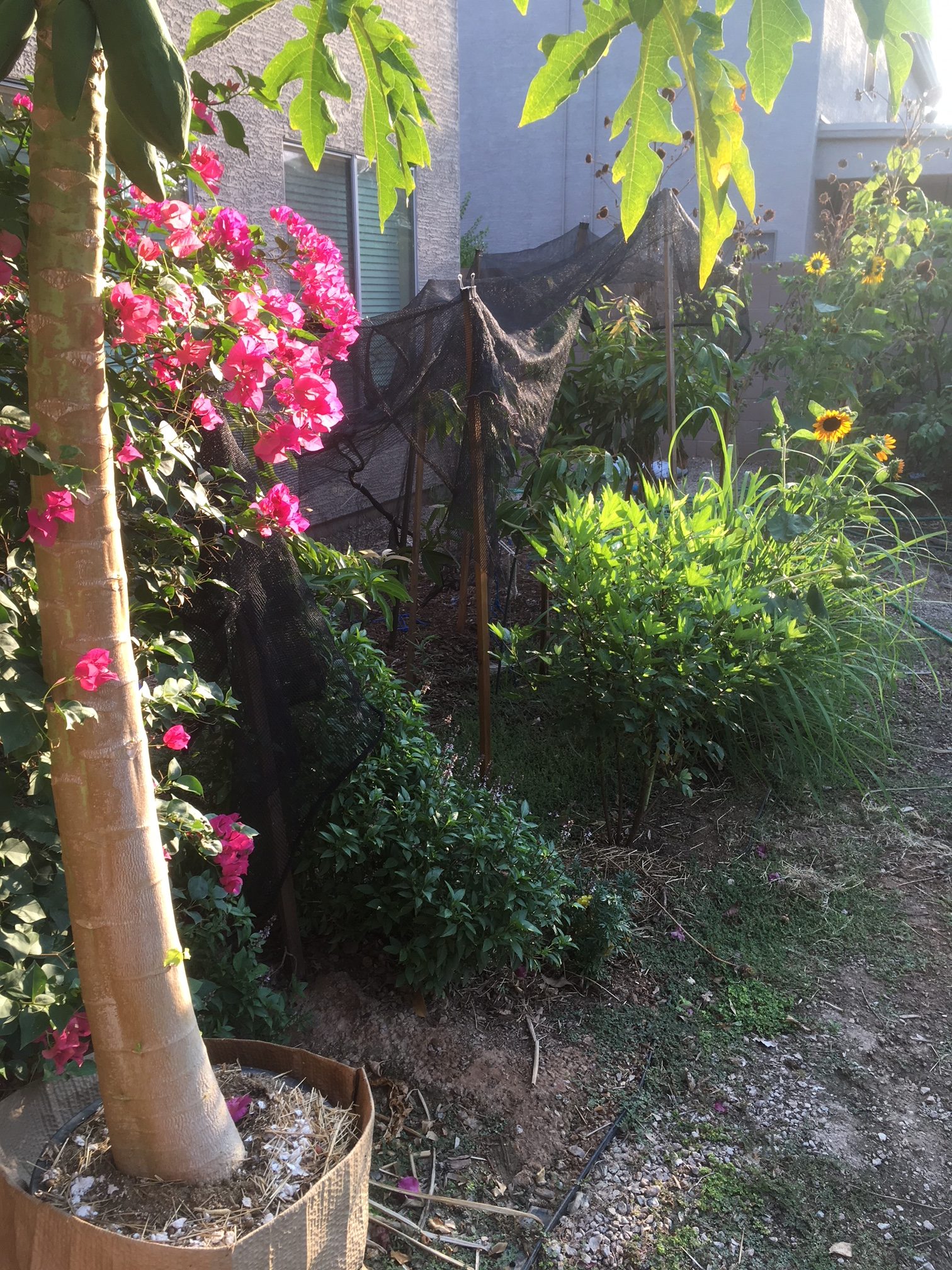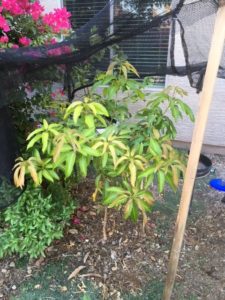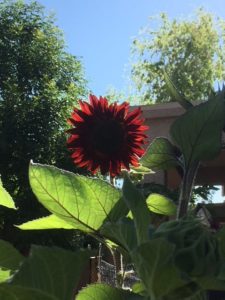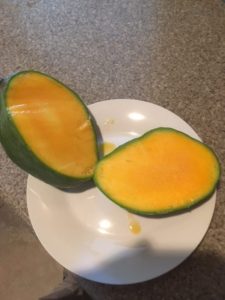13 Questions to Help Guide your Food Forest Design

When I first started my gardening adventure, I had no idea about the possibilities of growing in a limited amount of space. I live in a typical urban suburban community with cookie cutter houses on about 1/5th of an acre lot. Growing up, I always envisioned having a fruit tree or two in my backyard.
So naturally, when we purchased our first home I planted an orange tree (because that’s what people do in Phoenix), a plum tree, and a pomegranate. I assumed that would be the end of my gardening journey, but it turned out to be the beginning of a newfound passion.
How do you start creating a food forest design? A food forest design comes through careful planning of what edible plants and fruit producing trees you want to grow with the space that you have. Typically, a food forest consists of high density planting to maximize the space you have in order to produce as much food as possible.
Let’s take a look at some of the questions to consider and how to get started.
How do you decide what to grow in your yard?
I discovered that there are so many different factors that go into what to plant in your yard.
It can help to have some basic knowledge or plan before just putting things in the ground.
It can definitely be nice to have that blank canvas to work with and just create that dream garden that you envision.
With that being said, gardening is an art form, and you can always adjust over time.
There have been times where I didn’t like where I planted something and have moved it to a new location in the middle of our 110 degree heat, it just happens.
Create a plan
I would doodle sketches of my backyard, with where I wanted to place my raised beds or plant a fruit tree. There are various computer programs or apps that you could use to help you design your yard as well, but there is just something about writing it out that was always more meaningful to me.
I would spend time observing areas of my backyard to visualize what would work well in that area or even take pictures of my yard at various times to see how much sunlight that area was getting.
Having a plan can really help make your vision a reality and help to alleviate some of the possible planting errors that can be made along the way.
Brainstorm
This is where the fun happens, just thinking about all the different possibilities. Start making list of things that you are interested in doing or growing.
Check out pictures of other gardens that can help inspire the direction you want to go. Talk with other people to get ideas. Most of all enjoy the design process where you have endless possibilities.

When I started my backyard food forest I started pouring through research and ideas.
We moved about a year after I started really getting into building my first backyard food forest design, so I’ve been able to do this a couple times.
I’ve thought about some of the questions I had when getting started and have listed the major ones here to help you create your backyard food forest design.
RELATED POST: How to Start an Urban Garden in 5 Easy Steps
How much are you willing to work?
Anyone that lives in the desert knows that it’s quite common to see yards of rock, instead of lush green grass.
Our backyard was all landscape rock when we moved into our home. Talk about some back breaking work clearing that out to make way for planting.
You may have big dreams for your yard, but are you willing to do the physical labor that comes with creating that dream garden.
It’s not easy to dig those holes for your fruit trees or to build a raised bed, but the payoff is worth it.
How long are you willing to wait?
Some fruit trees take several years to start producing fruit, depending on the size of the tree.
For inpatient gardeners, this can be a big challenge.
There are fruit trees that will start producing fairly quickly and most garden vegetables will produce in a few months.
If you are unwilling to wait, it may influence whether or not you want to do more seasonal gardening with vegetables or go after the quicker producing fruit trees.
RELATED POST: Fruit Trees the Produce Fruit Fast
How much space do you have?
You can grow a ton of stuff in a small area, but it definitely comes with some limitations.
Examine the available areas you have for planting.
If you are living on acres of land, you have nothing to worry about when it comes to root systems or lack of pruning control.
If you are operating on a really tiny space like an apartment patio, finding things that do well in containers will be beneficial.
Survey your area to maximize your space and to determine how dense you will want to plant.
How much are you willing to maintain?
It is crazy the amount of time I commit to my garden.
During the summer months, I get up at 4:30am to water for several hours before I leave for work, then water again in the evening until bedtime.
When you have a variety of plants in containers and in the ground it starts adding up.
Watering is just the beginning, you’ll have to think about the time it takes for consistent feeding, pruning, watering, weeding, and bug control.
It may be best to start small and build as you go so as not to get overwhelmed or discouraged by the amount of time it can take.
Maintenance for me now is like second nature and tending my garden is something I enjoy.
What is your microclimate?
Knowing your yard is going to help ensure that you are planting in the right areas for your garden to flourish.
Think about things like what is the hottest spots in your yard, gets the most shade, is protected from winds, gets the coldest in the winter, or doesn’t dry out as quickly.
Taking all of the microclimates of your yard into consideration while help you with picking the right tree or plant to place in the right spots.
It is not a one size fits all approach when planting in your yard.
Even though you may not have a huge plot of land, it’ll surprise how much different your climates can be in various parts of your yard.
RELATED POST: Importance of Microclimates for Backyard Gardening
What grows well in your area?
I live in a hot, dry, desert climate. So, it’s best to start with plants that have been proven to work well in your climate.
After you master the easier plants, then you can start moving into things that are more of a challenge to grow.
Citrus is one of the most commonly grown fruit trees in my area (which actually isn’t the easiest fruit tree to grow here), and one of my first fruit trees to try growing.
I also selected a pomegranate which is known to be a highly drought tolerant fruit tree that is good for desert climates.
Get an idea for what people have had success growing in your area and build off of that.
Here are some easy things that anyone can grow.
When is the right time to plant?
For most people and places, the answer is going to be in the spring when the threat of frost has passed.
Living in the desert southwest, we have opportunities to plant at different times of the year.
Since we have sun pretty much year round and don’t get very cold in the winter, it provides us with the opportunity to plant at different times.
Spring and Fall are major planting times, but I’ve planted various things year round.
Certain times of the year have advantages and disadvantages.
For example, if you plant a fruit tree in the fall it can give it a chance to get its roots established before our extreme summer heat, but if it’s something that’s cold sensitive you may need to protect during potential frosts.
RELATED POST: When is the Best Time to Plant Fruit Trees in Hot Climates
Are you going for something that is aesthetically pleasing?
Yes, growing things that I can eat is probably one of the biggest reasons I garden, but I’ve grown to appreciate the beauty of gardening.
Some people love to grow flowers or spend a lot of time building various landscape features, planter boxes, water features, artifacts, or trellises for the purpose of creating a visually appealing garden.
I personally love the look that a fountain can add to the garden. Click here for some amazing fountains from my affiliates at Serenity Health.
As I’ve matured as a gardener, I’ve started to incorporate more of the colors and things that pop to the eye.

What are your soil conditions like?
It is important to learn a little bit about your soil before planting anything.
If you have fertile soils, you won’t have any problems planting anything in the ground. In the dry climates, that’s typically not the case.
If you have poor soil, then it may be best to utilize raised beds for gardening or containers.
There are also ways that you can work on improving your soil.
Most plants like a slightly acidic soil, so if you have a soil that is high PH, you may have to amend it.
Here is my post on amending clay soil.
Drought tolerant or not?
For us Southwest gardeners in a hot, dry climate it’s a good idea to look at plants that can withstand our lack of rain.
Of course we will be providing irrigation, but for water conservation and to save the hassle of having to water non-stop, it’s best to look at more drought tolerate plants.
How are you going to water?
If you live in a climate that gets a lot of rain throughout the year, than you may just need periodic supplemental watering’s.
For us gardeners in hot, dry climates, we need to provide continuous irrigation.
So, planning for how you are going to irrigate is critical for your gardening success.
You may need to install some sort of irrigation system, maybe you purchase a property that has flood irrigation, or maybe you will find that hose watering works for you.
What do you like to eat?
This is a big one for me. When I got into the fruit tree craze, it was easy to get caught up in trying to grow every exotic fruit tree possible, but as I started tasting fruits that were new to my palate, I realized it wasn’t worth the effort of trying to grow things that nobody cared to eat.
I also look at the difference in taste quality of the fruit or vegetable that is homegrown versus store bought.
For example, a homegrown tomato or mango blows away the store bought versions. Where-as homegrown onions, don’t taste that much better than store bought onions.
The last thing I consider is how much produce costs or even if you can get it in the stores. If I can get something for cheap in the store and it tastes decent, I’ll make growing other things a higher priority.

Where do I go to learn how to garden?
I’ve learned so much from the gardening communities in my area.
I’ve found that I’ve learned more from backyard gardeners than many of the mainstream nurseries.
I like to research and learn all I can about gardening, but just keep in mind that things that may work in one part of the world, may not work in your backyard.
Looking up various groups on Facebook is a great way to connect with other gardeners that share your same interests.
Going to various Farmer’s Markets or plant sales can help you to meet new growers.
I’ve found that many gardeners are some of the kindest people out there.
There are some great books and online resources to check out.
To summarize, preparing for your backyard food forest design is an exciting time.
It’s a blast thinking about all the possibilities and things you can do to create a beautiful garden.
As you consider the questions discussed above in your design process, it’ll help guide you in making the right decisions for planting to create the dream garden that you’ve always wanted.
Please comment down below and share anything that has helped you build your garden.
